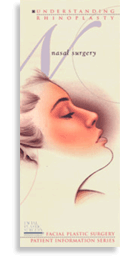Surgery of the Nose

The content on this page has been reviewed by NYC Rhinoplasty Specialist Dr. Joseph Rousso
Every year, half a million people who are interested in improving the appearance of their noses seek consultation with facial plastic surgeons. Some are unhappy with the noses they were born with, and some with the way aging has changed their nose. For others, an injury may have distorted the nose, or the goal may be improved breathing. But one thing is clear: nothing has a greater impact on how a person looks than the size and shape of the nose. Because the nose is the most defining characteristic of the face, a slight alteration can greatly improve one’s appearance.
If you have wondered how nose surgery, or rhinoplasty, could improve your looks, self-confidence, or health, you need to know how rhinoplasty is performed and what you can expect. No pamphlet can answer all your concerns, but this one can provide answers to many of the questions you may have.
Successful facial plastic surgery is a result of good rapport between patient and surgeon. Trust, based on realistic expectations and exacting medical expertise, develops in the consulting stages before surgery. Your surgeon can answer specific questions about your specific needs.
Is Rhinoplasty For You?

As with all facial plastic surgery, good health and realistic expectations are prerequisites. Understanding nasal surgery is also critical. Since there is no ideal in rhinoplasty, the goal is to improve the nose aesthetically, making it harmonize better with other facial features.
Skin type, ethnic background, and age are important factors to be considered in discussions with your surgeon prior to surgery. Before the nose is altered, a young patient must reach full growth, usually around age fifteen or sixteen. Exceptions are cases in which breathing is severely impaired.
Before deciding on rhinoplasty, ask your facial plastic surgeon if any additional surgery might be recommended to enhance the appearance of your face. Many patients have chin augmentation in conjunction with rhinoplasty to create a better balance of features.
Making the Decision For Rhinoplasty
Whether the surgery is desired for functional or cosmetic reasons, your choice of a qualified facial plastic surgeon is of paramount importance. Many facial plastic surgeons are trained in both ear, nose, throat, and facial cosmetic surgery, which provides you, the patient, with the highest level of training and expertise. Your surgeon will examine the structure of your nose, both externally and internally, to evaluate what you can expect from rhinoplasty. You are most likely to be pleased with the results of your surgery if you have a realistic idea of what nasal surgery can and cannot do.
You can expect a thorough explanation of the surgeon’s expectations and the risks involved in surgery. Following a joint decision by you and your surgeon to proceed with rhinoplasty, the surgeon will take photographs of you and discuss the options available. Your surgeon will explain how the nasal structures, including bone and cartilage, can be sculpted to reshape the nose and indicate how reshaping the chin, for example, could enhance the desired results.
After conducting a thorough medical history, your surgeon will offer information regarding anesthesia, the surgical facility to be used, and the costs for the procedure.
Understanding the Surgery
 The definition of rhinoplasty is, literally, shaping the nose. First, incisions are made and the bone and cartilage support system of the nose is accessed. The majority of incisions are made inside the nose, where they are invisible. In some cases, an incision is made in the area of skin separating the nostrils. Next, certain amounts of underlying bone and cartilage are removed, added to, or rearranged to provide a newly shaped structure. For example, when the tip of the nose is too large, the surgeon can sculpt the cartilage in this area to reduce it in size. The angle of the nose in relation to the upper lip can be altered for a more youthful look or to correct a distortion.
The definition of rhinoplasty is, literally, shaping the nose. First, incisions are made and the bone and cartilage support system of the nose is accessed. The majority of incisions are made inside the nose, where they are invisible. In some cases, an incision is made in the area of skin separating the nostrils. Next, certain amounts of underlying bone and cartilage are removed, added to, or rearranged to provide a newly shaped structure. For example, when the tip of the nose is too large, the surgeon can sculpt the cartilage in this area to reduce it in size. The angle of the nose in relation to the upper lip can be altered for a more youthful look or to correct a distortion.
The tissues are then redraped over the new frame and the incisions are closed. A splint is applied to the outside of the nose to help retain the new shape while the nose heals. Soft, absorbent material may be used inside the nose to maintain stability along the dividing wall of the air passages called the septum. Alternatively, soft nasal supports that permit nasal breathing post-operatively can be placed.
What to Expect After the Surgery
Immediately after surgery, a small splint will be placed on your nose to protect it and to keep the structure stable for at least five to eight days. If packing is placed inside the nose during surgery, it is removed the morning following the surgery. Your face will feel puffy,especially the first day after surgery. Pain medication may be required. Your surgeon will advise you to avoid blowing your nose for seven days after surgery. In the immediate days following surgery, you may experience bruising and minor swelling in the eye area. Cold compresses often reduce the bruising and discomfort. Absorbable sutures are usually used that do not have to be removed. Nasal dressing and splints are usually removed six or seven days after surgery.
It is crucial that you follow your surgeon’s directions, especially instructions to keep your head elevated for a certain period after surgery. Some activities will be prohibited in the weeks after the procedure. Sun exposure, exertion, and risk of injury must be avoided. If you wear glasses, special arrangements must be made to ensure that the glasses do not rest on the bridge of the nose. Tape and other devices are sometimes used to permit wearing glasses without stressing the area where surgery was performed.
Follow-up care is vital for this procedure to monitor healing. Obviously, anything unusual should be reported to your surgeon immediately. It is essential that you keep your follow-up appointments with your surgeon.
Insurance does not generally cover surgery that is purely for cosmetic reasons. Surgery to correct or improve nasal function or surgery for major deformity or injury may be reimbursable in whole or in part. It is the patient’s responsibility to check with the insurance carrier for information on the degree of coverage.
